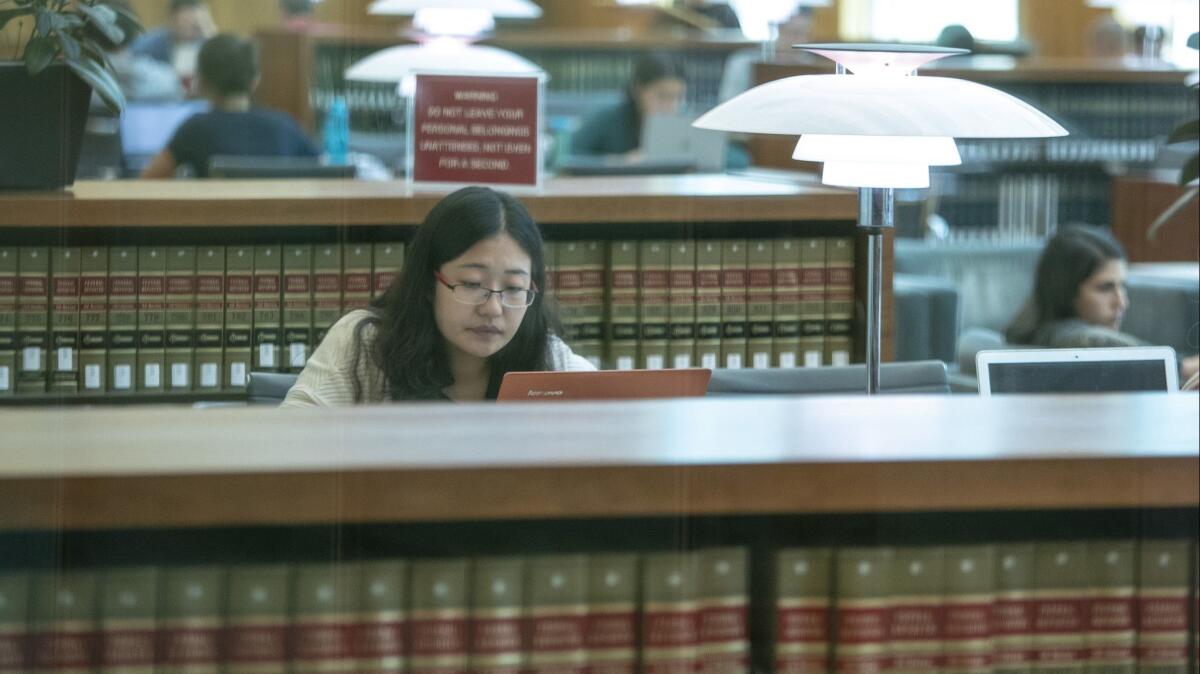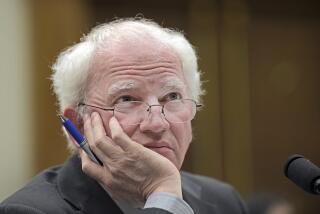Op-Ed: Why is it so much harder to become a lawyer in California than in New York?

The State Bar of California has done it again, failing nearly 60% of the law school graduates who took the exam in July. It was the worst outcome since 1951. And yet thousands of these graduates, if they had taken the test in virtually any other state, would now be embarking on their legal careers instead of having to prepare to take it again in February.
The score needed to pass the California bar exam — called the “cut score” — is 144. We are the only state to set its cut score above 140 other than Delaware (with 172 applicants, compared with California’s 8,071). This is profoundly out of line with the rest of the country. Nationwide, the median score needed to pass is 135.
In New York, the state with a legal practice most like California’s in scale and complexity, the cut score is 133. Among graduates of ABA-accredited law schools there, 83% passed the state bar exam the first time they took it. In California, though, the comparable rate was 64%. That likely would be 20 percentage points higher if our cut score matched New York’s. Is New York inflicting on its populace thousands of unqualified lawyers through its lower cut score? We have yet to hear of it.
There is no evidence that California’s high bar protects the public, and considerable reasons to believe it actually makes our lawyers less competitive.
The state bar, the California Legislature and the California Supreme Court — which has ultimate authority to set the cut score — need to bring rationality to our bar exam by aligning it with the standards of comparable states.
As law school deans, we witness the harm done to our graduates and to the legal profession by this unjustifiably high cut score. Those failing the bar risk losing their jobs. For the still unemployed, finding work becomes far harder. Even those who keep their jobs wear their bar performance as an albatross around their necks. The financial consequences are considerable: thousands of dollars in out-of-pocket costs for additional exam fees and review courses, often adding to already considerable indebtedness. Employers lose otherwise qualified employees or must provide them time off to study.
We recognize that some critics blame us for this situation. They say that we are admitting students to law schools who are not adequately qualified. From 2010 to 2017 there was a decline in LSAT scores and undergraduate GPAs of admitted law students in California and nationally, and there is undoubtedly some correlation between those metrics and performance on the bar exam, as well as in law school. However, while this may explain some of the recent decline in bar passage rates, it does not explain most of it, nor does this provide any legitimate reason for keeping California’s cut score so much higher than other states’.
It is more plausible to hypothesize that the bar exam has grown anachronistic, a test designed for a paper-and-pencil generation now inflicted on a smartphone generation. Memorizing large amounts of information and regurgitating it over a few days has little predictive power for lawyering competence today. Recent graduates may well be worse than their predecessors at this skill set — likely we all are — but they may be at least as good at other problem-solving skills lawyers need.
Enter the Fray: First takes on the news of the minute from L.A. Times Opinion »
Furthermore, the high cut score distorts California’s legal education, especially in our rapidly changing and increasingly competitive global legal marketplace. Over the last two decades, law schools have been asked to provide deeper field-specific education and more practical training; they responded by expanding clinical programs, finding externship opportunities and adding specialized courses. Many law schools now offer concentrations in areas such as intellectual property, the environment, health, tax, business, public interest, and labor and employment, where there are growing job opportunities in California. But — apart from some basic business law — none of these subjects is tested on the bar exam. This creates a core dilemma for our students: prepare for their legal careers, or prepare for the bar exam?
Thus far, the state bar’s — and the state Supreme Court’s — only action has been a call for continuing studies. Each of our law schools, along with eight other ABA-accredited California law schools, are participating in a bar-sponsored study of student data now. This will be followed by a “job performance” study that will take another two years. In the meantime, thousands of graduates of California law schools will have their lives needlessly turned upside down.
The bar exam is intended to be a measure of minimum competence to practice law following three rigorous years of law school. There is no evidence that California’s high bar protects the public, and considerable reasons to believe it actually makes our lawyers less competitive in the global legal marketplace. By all means, let’s keep studying the issues, but that shouldn’t hold us back from making the sensible decision to align the state’s cut score with the rest of the nation. Until this happens, California’s high failure rate remains both sui generis and a self-inflicted wound.
David L. Faigman is chancellor and dean at the UC Hastings College of the Law. Stephen C. Ferruolo is dean at the University of San Diego School of Law. Jennifer L. Mnookin is dean at the UCLA School of Law.
Follow the Opinion section on Twitter @latimesopinionand Facebook
More to Read
A cure for the common opinion
Get thought-provoking perspectives with our weekly newsletter.
You may occasionally receive promotional content from the Los Angeles Times.






